Niemann–Pick disease type-C Therapy Market
DelveInsight’s analysts assessed the of Niemann–Pick Type C therapeutics market in the 7MM to be around to be USD 28.676 million in 2017, which is expected to grow during the study period (2017-2028). Moreover, the NPC market share of prescription therapies was found to be USD 9.254 million in 2017 in the United States.
The Niemann–Pick Type C therapeutic market in 7MM is dominated with the use of Substrate Reduction Therapy – Zavesca/Brazaves [Miglustat; Actelion] and the supportive therapies. Zavesca [Miglustat], a substrate reduction therapy developed by Actelion Pharmaceuticals, has been only approved in the EU5 countries and Japna and not in the US on the ground of insufficient data. FDA requested for more data, which would take years to get, and almost impossible to satisfy the high standards of the FDA, mainly restrained by the limited or lack of patient population which could be recruited in the trials. However, the drug is already in the market for the treatment of Gaucher’s disease in the US. Thus it is being prescribed to the NPC patients as an off-label therapy.
Niemann–Pick disease type-C Pipeline
Of the emerging Niemann–Pick Type C therapies, VTS-270 (Mallinckrodt), Trappsol Cyclo (CTD Holdings), and Arimoclomol (Orphazyme) are expected to enter the NPC treatment market, with their respective products, during the forecast period (2019–2028). Key players like Mallinckrodt (VTS-270), CTD Holdings (Trappsol Cyclo), Orphazyme (Arimoclomol) and others are working towards the development of the eligible candidate for the Niemann–Pick Type C treatment.
Amongst all the three upcoming therapies, VTS-270 (Mallinckrodt) promises to benefit the NPC patients the most. VTS-270 is a cholesterol modulator, under a pivotal stage of development for the treatment of Niemann–Pick Disease-Type C. The drug has received various designations from the United States Food Drug and Administration (FDA)-Rare Pediatric Disease Designation, Promising Innovative Medicine (PIM) Designation, Breakthrough Therapy Designation, and Orphan Drug Designation for the treatment of NPC.
Another pharma company, CTD Holdings, is running the Phase-I/IIA clinical trials of its drug Trappsol Cyclo for the NPC treatment. It has also received Rare Pediatric Disease Designation, Orphan Drug Designation, and Fast-track designation by the US FDA for the treatment of Niemann–Pick Type C.
Trappsol Cyclo and VTS-270 are proprietary mixtures of hydroxypropyl-beta-cyclodextrins, and the only difference between the VTS-270 and Trappsol Cyclo is the route of administration, which ultimately leads to the different fate of these therapies. VTS-270 is an intrathecal preparation that can cross the Blood-Brain Barrier (BBB) and as a result, targets the neurological symptoms of NPC such as dementia and cataplexy. Whereas, Trappsol Cyclo is administered via intravenous route and thus targets the visceral symptoms, affecting the peripheral organs such as the spleen, liver, and lungs. In 2013, the FDA allowed NPC patients using Trappsol Cyclo on compassionate use to switch to VTS-270 (Kleptose HPB) without submitting a new protocol to the US FDA. Both of these drugs have already been given to the NPC patients under the Compassionate use Program.
Furthermore, apart from these cyclodextrin products Chaperone therapy has also been proved as a significant therapeutic option for the management of Lysosomal storage disorders [LSDs]. Based on this, Orphazyme is developing a chaperone therapy for NPC treatment as well.
Overall, the increasing diagnosed NPC prevalence along with the promising emerging pipeline therapies, will fuel the Niemann–Pick Disease-Type C1 market during the forecasted period of 2019–2028.



